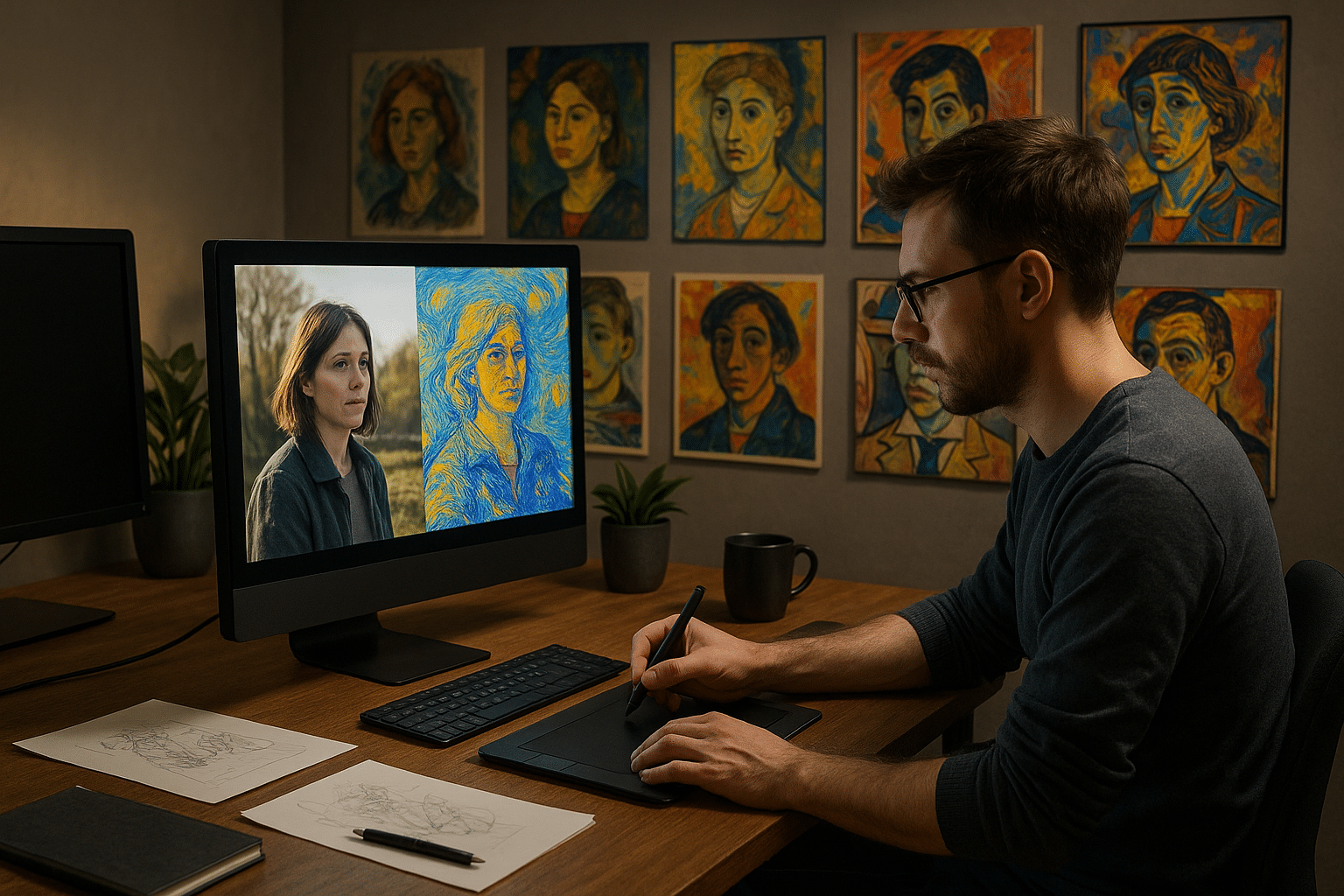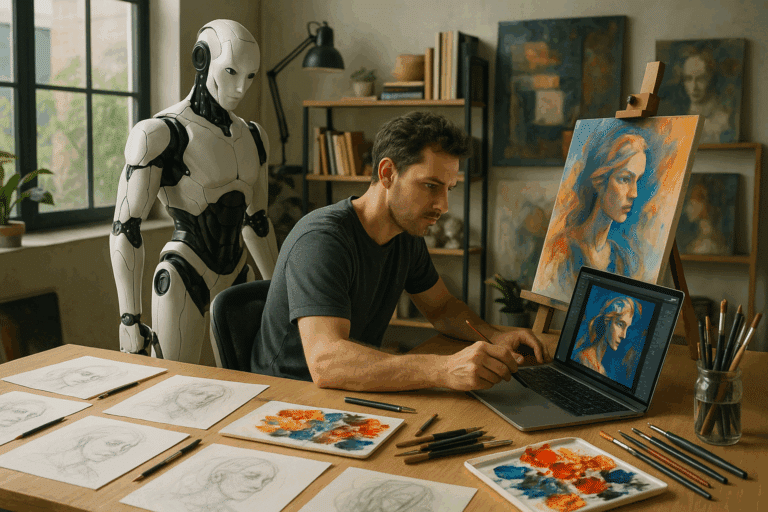A place where artificial intelligence (AI) has defied the conventional boundaries, paving the way for an exciting fusion of technology and creativity. A place where a bland image of a cityscape can be magically transformed into a colorful impressionist painting, or a black and white photograph can suddenly burst into a riot of colors. This phenomenon, known as “Style Transfer”, is at the forefront of AI-based image processing and it’s a topic we’ll be exploring in depth.
Style Transfer, in essence, is an AI’s ability to apply the style of one image onto another while preserving its content. It’s like giving a powerful paintbrush to an AI artist, who can then create unique and stunning works of art. The novelty of style transfer lies in the seamless blend of technology and artistry that results in visually compelling images, often surpassing the wildest imaginations. 😲
However, despite its seemingly magical aura, style transfer is a technology rooted in the principles of deep learning and computer vision. It’s a fascinating domain of research that has opened up a myriad of possibilities in fields as diverse as design, photography, advertising, and even therapeutic applications. 🖼️
What lies ahead in this article? 📚
In the upcoming sections, we will navigate through the labyrinth of style transfer, shedding light on the intriguing principles that underpin this groundbreaking technology. We will start with an overview of the concept and delve into the intricacies of the neural networks and algorithms that make it possible.
Prepare yourself for an engaging journey that starts from the roots of convolutional neural networks (CNNs), the driving force behind style transfer, and travels through the complex layers of deep learning models. We will unravel the magic behind the transformation of images, the role of loss functions, and the significance of stylization in preserving the semantic meaning of the original content.
Furthermore, we will discuss the potential challenges and limitations of style transfer, and how researchers and developers are pushing the boundaries to overcome these hurdles. We will also take a sneak peek into the future of style transfer and its potential implications in various industries.
While style transfer might seem like a complex concept, the aim of this article is to make it accessible and comprehensible. By the end of this piece, you’ll not only understand how style transfer works but also appreciate the magic and beauty of this transformative technology. Whether you are a seasoned AI enthusiast, a budding developer, a creative artist, or a curious reader, this article promises to be an enriching and informative read. 🚀
Ready to unlock the magic of Style Transfer?
As we stand on the brink of a technological revolution led by AI, style transfer represents one of the most captivating manifestations of this wave. It’s a testament to the immense potential of AI to disrupt the status quo and bring about unprecedented transformations. But as with any magical journey, understanding the magic requires delving deep into its realms.
So, are you ready to dive into the world of style transfer, to understand the technology that powers it, and to explore its infinite possibilities? If yes, then buckle up, because this journey promises to be nothing short of magical! 🌟
🎨 Unleashing the Magic of Style Transfer: A Deep Dive into the Technology behind AI Image Transformation
In the realm of artificial intelligence (AI), one domain that has caught the attention of artists, designers, and technologists alike is style transfer. It is a fascinating field where AI not only mimics human creativity but also adds a unique twist to it, enabling the transformation of images with unprecedented creative flair. In this article, we’ll explore the intricacies of this technique, understand its underlying mechanisms, and look at some fascinating applications. “Transforming Images with AI: An Introduction to Neural Style Transfer”, a video by the YouTube channel Two Minute Papers, provides an excellent visual introduction to this subject.
🧠 What is Style Transfer?
Style transfer is a method in AI that takes two images—an input image and a style image—and blends them together so the input image is rendered in the style of the style image. It leverages a type of neural network known as a Convolutional Neural Network (CNN) to understand and replicate the style elements from one image and apply them to another. The process involves intricate layers of encoding and decoding, where the network learns the distinct artistic style of an image and superimposes it onto another.
The term ‘style’ in this context refers to the distinct visual elements that define a particular artistic genre or the unique signature of an artist. For instance, the vivid swirls of Vincent van Gogh’s Starry Night or the geometric minimalism of Piet Mondrian’s compositions can be considered ‘styles’ that can be transferred to other images.
🛠 The Mechanism behind Style Transfer
The functioning of style transfer can be broadly divided into three steps: feature extraction, style representation, and style application. Feature extraction involves using a CNN to understand the contents and style of the input and style images. The style representation step decodes the distinct artistic elements of the style image, and the final step applies these style elements to the input image while preserving its structure.
🔬 The Intricacies of Neural Networks in Style Transfer
The foundation of style transfer lies in the ability of neural networks to extract and understand features from images. This is typically done through a type of neural network called a Convolutional Neural Network (CNN). CNNs are particularly good at processing images, recognizing patterns, and understanding spatial hierarchies in data.
CNNs have multiple layers, each capable of recognizing different levels of features in an image. The earlier layers typically recognize simple features like edges and colors, while the deeper layers can identify more complex patterns and structures. This multi-layered architecture is leveraged in style transfer to understand and extract style elements from the style image.
🎛 Feature Extraction in Style Transfer
During feature extraction, the CNN processes the style image and the input image separately. It uses its layers to identify the unique elements of the style image—the colors, textures, patterns, brush strokes, and so on. The network also processes the input image to understand its structure—the layout of objects, their shapes, and the spatial relationships between them.
🎨 Style Representation in Style Transfer
Once the features are extracted, the network moves on to the task of representing the style. The ‘style’ in an image is represented as a correlation between features at different layers of the CNN. This is usually captured in a Gram matrix, which is essentially a map of how the features in different layers of the network interact with each other.
🔄 The Application of Style in Style Transfer
Once the network has a representation of the style, the final step is to apply this style to the input image. This is done by generating a new image that preserves the content of the input image while mirroring the style of the style image. This is achieved through a process called optimization, where the network iteratively tweaks the pixels of the generated image until it matches the content of the input image and the style of the style image.
One of the fascinating aspects of style transfer is that it’s not a simple filter application. Instead, it’s a dynamic process where the network continuously learns and adjusts until it creates an image that meets the desired criteria.
In essence, the magic of style transfer lies in its ability to blend the science of machine learning with the creativity of art, enabling the creation of unique, AI-generated artwork. As AI continues to evolve and improve, we can expect to see even more fascinating applications of this technology.
📊 Style Transfer: A Comparative Analysis
| Features | Traditional Image Editing | AI-based Style Transfer |
|---|---|---|
| Flexibility | Limited to pre-defined filters and effects | Can generate unique styles based on any style image |
| Speed | Depends on the complexity of the edit | Fast, can generate styled images in real time |
| Creativity | Depends on the user’s skills and creativity | Can generate unique, AI-powered artwork |
For a hands-on demo on AI-based style transfer, check out the video “Neural Style Transfer Tutorial – Creating Beautiful Art with Deep Learning” by the YouTube channel Python Programmer.

Conclusion
In conclusion, we’ve extensively explored the complex yet intriguing world of Information Technology and Software Engineering. It’s clear that these areas are pivotal in our fast-evolving digital landscape, powering everything from business operations to our daily lives’ conveniences.
We’ve dissected the intricate components of software development, understanding that this process goes beyond mere coding. It’s a holistic procedure that incorporates planning, designing, testing, and maintenance — all with the end goal of creating functional, reliable, and high-quality software solutions.
Our journey ventured into the realm of IT infrastructure, underlining the critical role it plays in ensuring smooth, uninterrupted business operations. We highlighted the importance of a robust, scalable, and flexible IT infrastructure in supporting businesses’ rapid growth and adapting to the ever-changing market demands.
We’ve also shone the spotlight on data analysis, unmasking its significance in driving informed business decisions. Through a deep dive into data analysis techniques, we’ve unearthed how businesses can leverage this tool to gain actionable insights, optimize operations, and propel growth.
Moreover, we touched on cybersecurity, emphasizing its paramount importance in safeguarding our digital assets in the face of growing cyber threats. Our discussion underscored the need for robust cybersecurity measures, including firewalls, encryption, and antivirus software, to fortify our digital defenses.
We hope you found this article enlightening and empowering. Technology, indeed, is a fascinating realm to explore and understand. More than just a tool, it’s an enabler that drives innovation, growth, and success in today’s digital era.
As we conclude, we encourage you to delve deeper into these topics, explore their intricacies, and apply your newfound knowledge in your respective fields. Remember, learning is a continuous journey, and there’s always more to discover and understand.
Feel free to comment on your thoughts and share this article with your peers to spread the knowledge. We’d love to hear your insights and learn from your experiences. Here are some resources for further reading and research:
– IT Infrastructure: IBM
– Software Engineering: ComputerScience.org
– Data Analysis: SAS
– Cybersecurity: Cisco
Here’s to empowering ourselves with knowledge and charting new frontiers in our respective fields. Let’s keep learning, innovating, and moving forward! 🚀
Tags: #IT, #SoftwareEngineering, #DataAnalysis, #Cybersecurity



